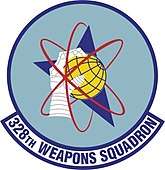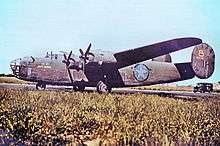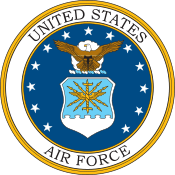328th Weapons Squadron
The United States Air Force's 328th Weapons Squadron is an USAF Weapons School training unit located at Nellis Air Force Base, Nevada.
328th Weapons Squadron
 | |
|---|---|
 USAF Cyberwarriors at the 624th Operations Center, located at Joint Base San Antonio, Texas | |
| Active | 1942–1994; 2003–Present |
| Country | |
| Branch | |
| Role | Advanced Space Superiority and Cyberspace Warfare Operations Training |
| Part of | Air Combat Command |
| Garrison/HQ | Nellis Air Force Base, Nevada |
| Engagements | World War II
1991 Gulf War (Defense of Saudi Arabia; Liberation of Kuwait)[1] |
| Decorations | Distinguished Unit Citation (2x) Air Force Outstanding Unit Award (9x)[1] |
| Insignia | |
| 328th Weapons Squadron emblem (approved 12 April 1955)[1] |  |
| 328th Bombardment Squadron emblem (c. 1943)[2] |  |
The squadron's origins trace back to the 328th Bombardment Squadron (Heavy) activated on 28 January 1942. The 328th Bombardment Squadron received a Distinguished Unit Citation for its gallantry during the raid on the Ploiești, Romania oil refineries during August 1943. The 328th flew the Boeing B-29 Superfortress, Boeing B-47 Stratojet, Boeing B-50 Superfortress, and Boeing B-52 Stratofortress during the Cold War.
Mission
The 328 WPS is one of eighteen squadrons at the United States Air Force Weapons School. The 328 WPS is the largest squadron within the USAF Weapons School and manages two separate syllabi: the Space Superiority Weapons Instructor Course (WIC) and the Cyberspace Warfare Operations WIC.
History
World War II


Established in early 1942 initially as a Consolidated B-24 Liberator reconnaissance squadron, flying antisubmarine patrols. Later trained under Third Air Force in Florida. Completed training in late 1942; deployed to the European theater of operations as one of the initial heavy bomber squadrons assigned to VIII Bomber Command in England, September 1942.
Engaged in long-range strategic bombardment operations over Occupied Europe. Deployed to IX Bomber Command in Egypt in December 1942; operating from airfields in Libya and Tunisia. Raided enemy military and industrial targets in Italy and in the southern Balkans, including the Nazi-controlled oilfields at Ploiești, Romania, receiving a Distinguished Unit Citation for its gallantry in that raid. Also flew tactical bombing raids against Afrika Korps defensive positions in Tunisia; supporting British Eighth Army forces in their advance to Tunis, in September and October 1943.
Returned to England with disestablishment of IX Bomber Command in North Africa. From England, resumed long-range strategic bombardment raids on Occupied Europe and Nazi Germany, attacking enemy military and industrial targets as part of the United States' air offensive. The squadron was one of the most highly decorated units in the Eighth Air Force, continuing offensive attacks until the German capitulation in May 1945.
Returned to the United States in June 1945; being remanned and re-equipped with Boeing B-29 Superfortress heavy bombers. Trained for deployment to the Central Pacific area to carry out very long range strategic bombing raids over Japan. Japanese capitulation in August canceled plans for deployment, instead became Continental Air Forces (later Strategic Air Command) B-29 squadron.
Cold War
During the Cold War, the squadron was equipped with new weapons systems as they became available, performing strategic bombardment training with the Boeing B-50 Superfortress, an advanced version of the B-29 in 1950. The B-50 gave the unit the capability to carry heavy loads of conventional weapons faster and farther as well as being designed for atomic bomb missions if necessary.
By 1951, the emergence of the Soviet Mig-15 interceptor in the skies over North Korea signaled the end of the propeller-driven B-50 as a first-line strategic bomber. The squadron received Boeing B-47 Stratojet jet bombers in 1954. In 1955 it began receiving an early model of the Boeing B-52 Stratofortress and upgraded to various models over the next 40 years. Taken off nuclear alert after the end of the Cold War, the squadron was inactivated in 1994 with the inactivation of its parent unit and the close of Castle Air Force Base.
The squadron deployed aircraft and personnel to the 1708th Provisional Bombardment Wing at Prince Abdullah Air Base, Jeddah, Saudi Arabia, from August 1990 and to the 4300th Provisional Bombardment Wing at Diego Garcia Air Base, British Indian Ocean Territories from January 1991 for Operation Desert Storm. Both deployments terminated in March 1991.
Modern era
The Air Force Weapons School's Space Division was activated in July 1996 and the Space Division was replaced by the 328th Weapons Squadron on 3 February 2003. The unit has graduated over 250 weapons officers.
Lineage
- Constituted as the 328th Bombardment Squadron (Heavy) on 28 January 1942
- Activated on 1 March 1942
- Redesignated 328th Bombardment Squadron, Heavy on 20 August 1943
- Redesignated 328th Bombardment Squadron, Very Heavy on 23 May 1945
- Redesignated 328th Bombardment Squadron, Medium on 28 May 1948
- Redesignated 328th Bombardment Squadron, Heavy on 1 February 1955
- Redesignated 328th Bomb Squadron on 1 September 1991
- Inactivated on 15 June 1994
- Redesignated 328th Weapons Squadron on 24 January 2003
- Activated on 3 February 2003[1]
Assignments
- 93d Bombardment Group, 1 March 1942 (attached to 93d Bombardment Wing after 10 February 1951)
- 93d Bombardment Wing, 16 June 1952
- 93d Operations Group, 1 September 1991 – 15 June 1994
- USAF Weapons School, 3 February 2003 – present[1]
Stations
|
|
Aircraft operated
- Consolidated B-24 Liberator (1942–1945)
- Boeing B-29 Superfortress (1945–1949)
- Boeing B-50 Superfortress (1949–1954)
- Boeing B-47 Stratojet (1954–1955)
- Boeing B-52B Stratofortress (1955–1965)
- Boeing B-52D Stratofortress (1956–1958)
- Boeing B-52E Stratofortress (1957–1958; 1967–1970)
- Boeing B-52F Stratofortress (1958–1974)
- Boeing B-52G Stratofortress (1966–1967; 1974–1994)
- Boeing B-52H Stratofortress (1974–1993)
References
- Notes
- Aircraft is Consolidated B-24J-55-CO Liberator serial 42-99949 on a mission to Friedrichshafen Germany on 14 August 1944. This plane was lost on 21 September 1944 in a mid-air collision with B-24H serial 42-94969) from the 330th Bombardment Squadron. Both planes crashed near Ingelmunster, Belgium.
- Citations
- Bailey, Carl E. (10 December 2007). "Factsheet 328 Weapons Squadron (ACC)". Air Force Historical Research Agency. Retrieved 28 July 2017.
- Watkins, p. 48
- Station number in Anderson.
Bibliography
![]()
- Maurer, Maurer, ed. (1983) [1961]. Air Force Combat Units of World War II (PDF) (reprint ed.). Washington, DC: Office of Air Force History. ISBN 0-912799-02-1. LCCN 61060979. Retrieved 17 December 2016.
- Maurer, Maurer, ed. (1982) [1969]. Combat Squadrons of the Air Force, World War II (PDF) (reprint ed.). Washington, DC: Office of Air Force History. ISBN 0-405-12194-6. LCCN 70605402. OCLC 72556. Retrieved 17 December 2016.
- Ravenstein, Charles A. (1984). Air Force Combat Wings, Lineage & Honors Histories 1947–1977. Washington, DC: Office of Air Force History. ISBN 0-912799-12-9. Retrieved 17 December 2016.
- Watkins, Robert (2008). Battle Colors: Insignia and Markings of the Eighth Air Force in World War II. Vol I (VIII) Bomber Command. Atglen, PA: Shiffer Publishing Ltd. ISBN 0-7643-1987-6.
External links
- The 93rd Bombardment Group Museum, Station 104, Hardwick. A small museum on the actual airfield site in Nissen (Quonset) and brick built huts.

